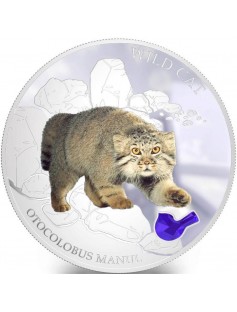- Low mintage limit, only 5,000
- Coin in capsule + with Certificate of Authenticity + BOX
- Fourth coin in Wild Cats series
- Pre-sale date after 09 May 2014
- Coin not issued yet. Be Firt who will get it
- Coin with Swarovski crystal
Pallas's cat is about the size of a domestic cat, its body is 46 to 65 cm (18 to 26 in) long and its tail is 21 to 31 cm (8.3 to 12 in) long. It weighs 2.5 to 4.5 kg (5.5 to 9.9 lb). The combination of its stocky posture and long, dense fur makes it appear stout and plush. Its fur is ochre with dark vertical bars on the torso and forelegs. The winter coat is greyer and less patterned than the summer coat. There are clear black rings on the tail and dark spots on the forehead. The cheeks are white with narrow black stripes running from the corners of the eyes. The chin and throat are also white, merging into the greyish, silky fur of the underparts. Concentric white and black rims around the eyes accentuate their rounded shape. The legs are proportionately shorter than those of other cats, the ears are set very low and wide apart, and it has unusually short claws. The face is shortened compared with other cats, giving it a flattened face. The shorter jaw has fewer teeth than is usual among felids, with the first pair of upper premolars being absent.
Distribution and habitat.
Pallas's cats are native to the steppe regions of Central Asia, where they inhabit elevations of up to 5,050 m (16,570 ft) in the Tibetan Plateau. They inhabit Mongolia, Tajikistan, Kyrgyzstan, Pakistan, Kazakhstan, Kashmir, and occur across much of western China. They are also found in the Transbaikal regions of Russia, and less frequently in the Altai, Tyva, and Buryatia Republics. In 1997, they were reported for the first time as being present in the eastern Sayan Mountains.
Until the early 1970s, only two Pallas's cats were recorded in the Transcaucasus, both encountered near the Araks River in southeastern Armenia, but no records existed from Azerbaijan. Populations in the Caspian Sea region, in Afghanistan and Pakistan, are thought to be declining and becoming increasingly isolated.
In 2008, an individual was camera-trapped in Iran's Khojir National Park for the first time. In 2012, Pallas' cats were recorded by camera traps in Bhutan's Wangchuck Centennial Park. This is the first report of Pallas' cat occurring in the Eastern Himalayas.





